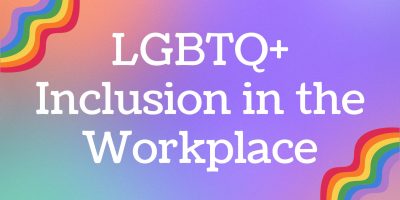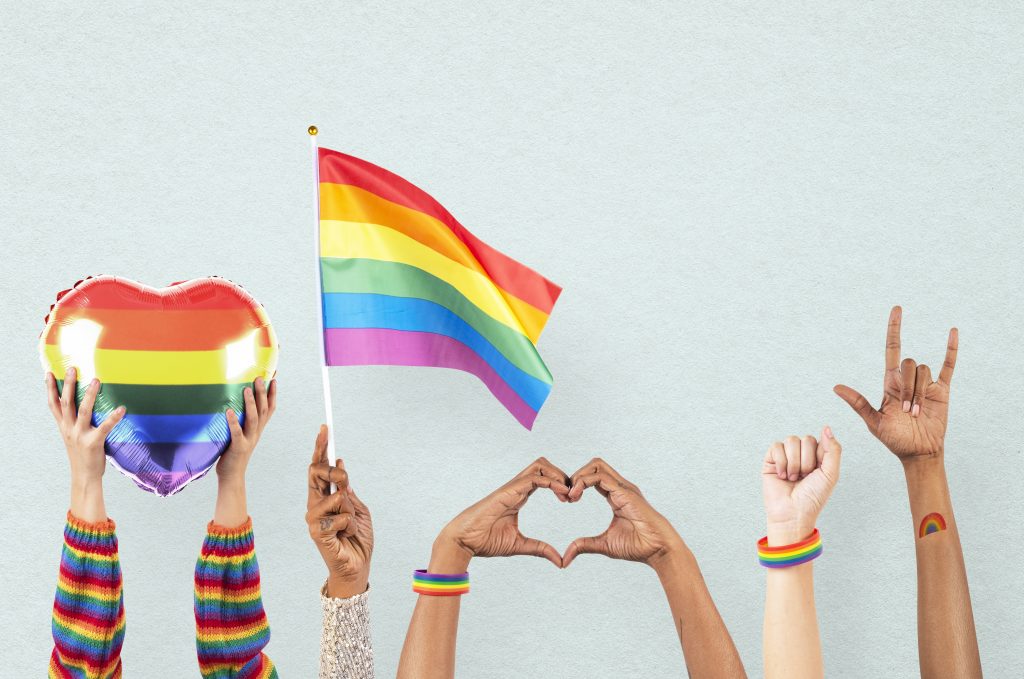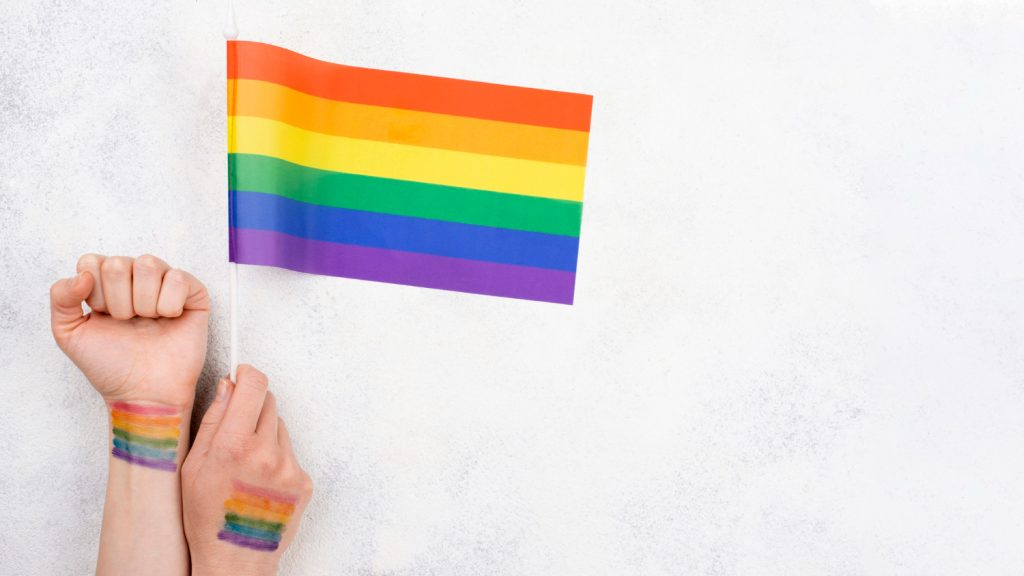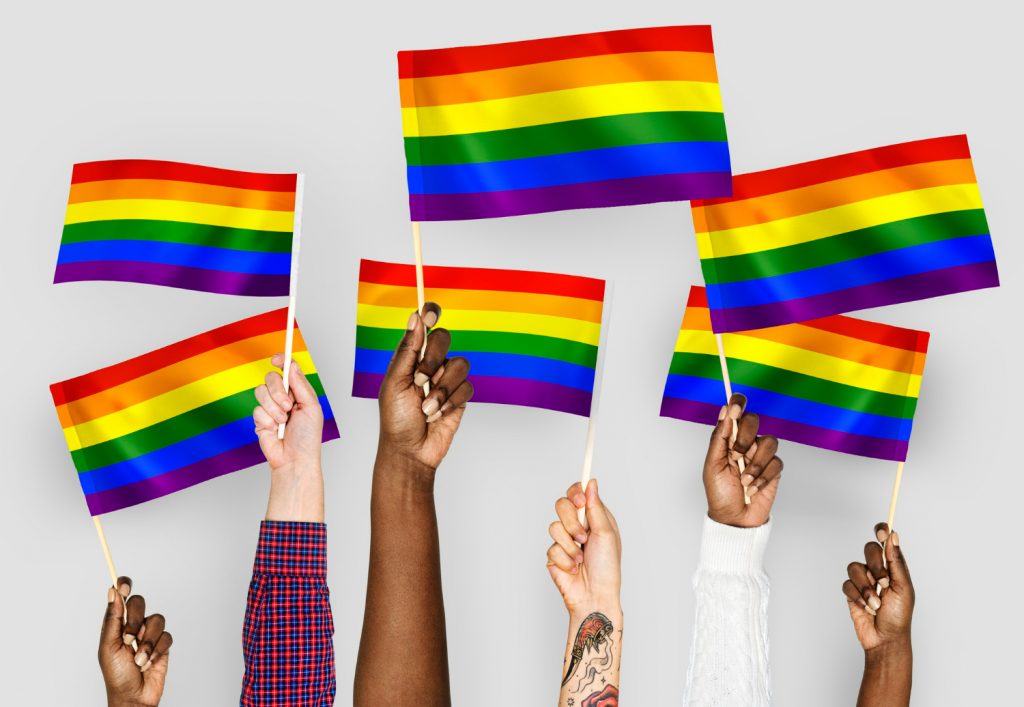
LGBTQ+ Inclusion in the Workplace
Creating a safe and inclusive society is impossible when the workplace does not reflect that. Thus, corporate America has some catching up to do when it comes to LGBTQ+ inclusion in the workplace.

With Pride Month around the corner, the LGBTQ+ rights movement is gaining momentum.
From companies pledging their allegiance to rainbow-themed rebrands, numerous campaigns are in the making, with more to follow in the upcoming weeks. Although they do an excellent job of increasing awareness in the workplace and beyond, many of these campaigns are short-lived.
While adequately using company resources can create long-lasting, tangible change, failure to do so inevitably asks how to celebrate Pride Month at work “the right way” and why it is such an urgent matter for employers.
To answer it, in this Shortlister article, we explore the best practices for celebrating Pride Month in the workplace and how it can benefit businesses and their employees.
Pride Month, celebrated annually in June, holds significant historical importance for the LGBTQ+ community.
It commemorates the Stonewall Uprising of June 1969, a pivotal event that sparked the modern LGBTQ+ rights movement. During that time, community members bravely stood against police harassment and discrimination after a violent raid on the Stonewall Inn, a gay bar in New York City.
Although the gay rights movement started long before the Stonewall Riots, this became the key event to mark this community’s fight for justice and rights. It launched political activism and numerous gay rights organizations.
The following year, the first marches were held in several US cities to commemorate the riots.
Since then, Pride Month has evolved into a time to honor and celebrate the diversity, resilience, and achievements of the LGBTQ+ community.
As acceptance is rising among Americans, the event is expanding. According to the Guinness World Records, the New York City Pride March in 2019 had an estimated five million attendees.
This is an excellent example of how far the movement has come, but also a reminder that we still have a long way to go before we talk about complete inclusion, both in the workplace and society.
For a long time, the LGBTQ+ community has had to deal with discrimination, exclusion, and violent behavior. Although somewhat less severe, prejudice remains an issue to this day.
According to Gallup research, 7.1% of the US population doesn’t identify as straight or cisgender. This is more prevalent in younger generations, with 20.8% of Generation Z adults identifying as LGBTQ+, compared to 10.5% of Millennials, 4.2% of Generation X, and 2.6% of Baby Boomers.
The numbers suggest that even small companies with less than 20 workers could have at least one LGBTQ+ employee.
At the same time, statistics show that almost one in five LGBTQ+ employees have been subjected to hostile workplace comments or conduct.
Therefore, it’s paramount for any workplace, as a significant part of people’s lives, to become a safe space for every employee equally.
Recognizing and celebrating Pride Month in the workplace fosters an inclusive environment. By doing so, organizations demonstrate their commitment to equality, diversity, and respect for all employees, regardless of their sexual orientation or gender identity. At the same time, they can reap benefits ranging from improved company culture to a better bottom line.
Societal stereotypes and biases are much easier to create than overcome, and the anti-LGBTQ+ movement is a perfect example of this.
Although other forms of sexuality and gender identities have existed since ancient civilizations, their acceptance drastically differs depending on the historical period and culture.
Nowadays, when anti-LGBTQ+ legislation is on the rise, celebrating Pride Month sends a powerful message about embracing authenticity and encouraging openness.
For employers, this practice not only honors LGBTQ+ employees and promotes equality but also benefits the organization considerably. By fostering a diverse and inclusive culture, companies can enhance productivity, improve morale, build stronger customer relationships, and attract top talent.
Ultimately, embracing the spirit of Pride Month and displaying the willingness to support their workforce equally gives employers a crucial role in reducing bias and paving the way for a more accepting society.
Due to this, here are some of the most significant benefits of celebrating pride month.
Company culture often indicates how an employer treats employees, so nurturing positive organizational values is integral to the workplace. In fact, Job Seeker Nation’s 2018 survey reveals that it’s at least of relative importance for 88% of the respondents and very important for 46%.
Actively celebrating Pride Month shows employers value all workers equally, thus creating a welcoming environment for everyone.
As a result, this fosters a sense of belonging and encourages individuals to be open and honest at work, further enhancing positive company culture and values.
When the workforce feels respected and supported, it tends to show higher levels of engagement. Therefore, an inclusive and positive company culture will increase employee productivity.
Countless studies have shown that diversity in the workplace is the engine that drives company growth. For example, according to Eagle Hill’s survey, it impacts 76% of employee productivity and efficiency.
Moreover, McKinsey’s 2020 report “Diversity Wins: How Inclusion Matters” reveals that the most diverse employers are more likely to outperform their competitors. However, it also mentions that employers must take bold actions to ensure a culture of inclusion.
Celebrating Pride Month in the workplace is one way to do that since it strengthens inclusion and diversity and creates opportunities to improve the corporate culture, affecting all aspects of business prosperity.
A happy employee is a loyal one.
An article on the main drivers of happiness at work, published by the Wall Street Journal, reveals that employees who feel happy, compared to their least happy co-workers:
Acknowledging the LGBTQ+ rights movement sends a positive message to employees, affirming their identities and validating their experiences. This recognition creates a sense of gratification, boosts morale, and enhances overall job satisfaction.
Considering the effect of an inclusive culture, it’s safe to assume that supporting LGBTQ+ rights can contribute to greater employee morale, thus benefiting the employer in many ways.
Attracting new customers and maintaining relationships with existing ones is imperative for any business. But how does celebrating Pride Month in the workplace fit into this?
For starters, 34% of customers are more likely to purchase from a brand that supports the LGBTG+ movement, as opposed to 19% of respondents who are less likely, reports NBC News. Moreover, Americans seem to have high expectations of business owners since more than half urge CEOs to help shape LGBTQ+ rights policies.
Another research published by Harvard Business Review shows that progressive companies that value diversity are 70% more likely to capture new markets.
Between this and the socially conscious younger generations who are set to take over the role of leading spenders, commemorating Pride Month helps companies attract and retain consumers who align with their values, leading to increased customer relationships and positive brand perception.
Finally, corporate diversity statistics show that 40% of employees would choose a company that supports inclusion over one that doesn’t. Additionally, 23% of respondents reported leaving an employer because of this.
This demonstrates that businesses prioritizing diversity and inclusion initiatives have a distinct advantage in a highly competitive talent market.
Therefore, by celebrating Pride Month, they can showcase their commitment to creating an inclusive and ethical workplace and attract top talent that appreciates the same values, including LGBTQ+ job seekers. Moreover, when employees witness their employer actively supporting Pride Month, they are more likely to feel a stronger connection, increasing their loyalty and reducing turnover rates.

There’s a vast collection of activities and event ideas for Pride Month at work that companies can implement. However, before they commit time and resources towards hosting panel discussions or fundraising events, employers must lay the groundwork for inclusivity – a welcoming environment, education, and employee support.
Embracing people from different backgrounds, ethnicities, genders, and sexualities is what makes a work environment welcoming. When employers allow every individual to contribute with their unique experience and point of view, they set the foundation for an inclusive and prosperous workplace.
Some tips for creating a welcoming work environment include:
Educating employees on LGBTQ+ rights and issues is necessary to create a welcoming work environment. Seeing how hostility is based on inaccurate information and stereotypes, it’s of utmost importance for companies to foster understanding through learning.
To do that, employers can offer DE&I training sessions or inclusion workshops that provide information on LGBTQ+ terminology and history and tackle the community’s challenges. This education can help dispel the myths and address LGBTQ+ biases, creating an accepting workforce free from ignorance and prejudice.
Change happens when people stick together.
As more people join a cause, it becomes easier to push positive societal changes. Take, for example, the Women’s March in Washington in 2017. This event united between 3.2 and 5.2 million men and women from the US alone, then it spread to least 80 other countries, gathering international support.
Regarding LGBTQ+ rights and workplace inclusion, support plays a vital role. Considering this, the employer can encourage their workforce to become allies and visibly support their LGBTQ+ co-workers. From active listening to taking action, these are some of the ways companies and their workers can be allies and support the community:
Education, support, and an inclusive environment are the pillars of LGBTQ+ inclusion in the workplace. However, businesses should go the extra mile in commemorating Pride Month. It means continuing their practice of promoting inclusivity and acceptance through educational events and inclusive activities.
With that in mind, as we approach Pride Month, here are some of the best pride event ideas for work that companies can implement.
Organizing an LGBTQ+ awareness day can be a powerful way to kickstart Pride Month at work.
Moreover, choosing a day commemorating a milestone, like the Stonewall Uprising, could be even more impactful. Companies could promote education and encourage workers to wear pride-themed accessories and rainbow colors to show support.
An even more effective way to honor the day is to invite local LGBTQ+ organizations. They can set up informational booths, conduct inclusion workshops, and provide resources for additional support.
Another way to commemorate Pride Month at work, which could be on the designated awareness day, is by arranging a series of educational and engaging talks by prominent LGBTQ+ speakers or business leaders.
They can share their experiences and insights, tell inspiring stories, and reduce prejudice by ongoing stereotypes.
Hosting someone like Inga Beale or Nicola Adams can provide valuable perspectives on workplace diversity and LGBTQ+ inclusion in all spheres of life.
Smaller businesses can also book local activists or entrepreneurs who can share their points of view on LGBTQ+ diversity, equity, and inclusion in the workplace.

In today’s digital age, social media plays a crucial role in spreading messages of inclusivity. It’s also an effective way to broaden the customer base and attract new buyers, especially the younger generations. In fact, one research shows that 76% of Gen Z want brands to address diversity and inclusion, followed by 72% of Millennials, 63% of Gen X, and 46% of Baby Boomers.
Setting up a pride-themed photo booth might encourage employees to capture and share their support for the LGBTQ+ community. That way, they can create inclusive content for the brand, while openly and publicly supporting the cause.
The booth can be decorated with colorful props, banners, social media hashtags, or photo frames. It’s a simple yet fun educational activity that can amplify a company’s commitment to inclusivity and generate positive internal and external engagement.
A dedicated hour of the day, week, or month where employees can destress and engage with their colleagues is always a good idea. This offers an informal setting for them to connect, relax and converse.
Making it pride-themed creates an opportunity to foster a sense of togetherness and LGBTQ+ celebration within the workplace.
Pride-themed bulletin boards can serve as a visual representation of the company’s commitment to LGBTQ+ inclusivity. HR can set up and decorate the board with educational resources, informative infographics, milestones, history, and activists.
The board can also encourage LGBTQ+ employees and allies to share their personal stories. This creates an open and inviting company culture where people feel safe expressing themselves without judgment.
Pride activities at work, like trivia nights, are entertaining and educational.
They are interactive and can facilitate a safe space for learning. Thus, crafting questions that challenge stereotypes and misconceptions surrounding the LGBTQ+ community is an opportunity to provide other employees with accurate information on the topic.
In return, a simple game night can turn into an engaging workplace event that promotes understanding and debunks harmful stereotypes.
One of the best ways for employers to support LGBTQ+ rights is by funding this community’s causes and organizations. This can make a genuine impact and is an excellent way to commemorate Pride Month.
Employers can encourage their employees to contribute donations or volunteer time for other LGBTQ+ initiatives and partner up with local charities and non-profit organizations. At the same time, by participating themselves, they showcase their commitment to social responsibility and community engagement.
A panel discussion is a medium for experts in a particular field or topic to share their knowledge, express opinions, and encourage dialogue. As such, when it touches on the subject of LGBTQ+ rights, it can shed light on equality, the challenges, and the goals of this community.
Creating a safe space for open dialog can foster a deeper understanding and empathy towards a group often discriminated against and ultimately promote a more accepting and inclusive work environment.
However, choosing panelists for the discussion is a crucial step. For the best and most credible results, the experts should be well-versed in LGBTQ+ workplace inclusion, legal rights, mental health, etc., to dispel myths and address the misconceptions about this community.
Finally, another way to demonstrate the employer’s commitment to LGBTQ+ causes is to sponsor an organization or event, typically one that is local. This could involve anything from providing financial support, volunteering time and resources, or offering company-wide participation in LGBTQ+ community initiatives.
Ultimately, partnering with LGBTQ+ organizations provide tangible support and strengthens community ties, illustrating solidarity within the community.
Every June, major corporations like Google, Microsoft, and Amazon stand at the forefront of pride celebrations.
Google, for example, has done a lot for employees who don’t identify as straight or cisgender. The company offers supportive communities, tools, and employee benefits. Additionally, last year, Google featured its “LGBTQ-friendly” and “transgender safe space” attributes. They allowed businesses across Europe to activate them in support of the community so that they know where they feel welcomed.
Microsoft, other than donating $170,000 to nonprofits, launched Microsoft Unlocked, a platform where they post LGBTQ+ stories and immersive experiences, along with other content. The company also expanded its reach to the metaverse, hosting a “Pride has no borders” virtual event.
Finally, Apple has supported Pride Month since the 2014 San Francisco march. In 2022, the brand invested money in launching a new product. Their pride-edition Apple watch featured a rainbow band, with shades of black, brown, and pink, as a way to recognize trans, Black, and Latinx communities. Then, the company donated a portion of the profits from this product to LGBTQ+ advocacy groups.
These are just a few of the many examples across large corporations that celebrate pride and other businesses of all sizes. Considering their global audience of millions, they’re excellently spreading awareness and supporting the cause, setting an example for others yet to catch on to diversity, inclusion, and equality in the workplace and beyond.

Businesses should keep in mind that demonstrating their commitment to diversity and equality should go beyond Pride Month since it’s a matter that requires continuous attention.
Although support for federal LGBTQ+ nondiscrimination protections hit record numbers, the number of anti-LGBTQ+ legislations is also increasing, creating an urgent need for increased support.
Hence, by understanding how to celebrate pride month at work most efficiently and its importance, employers play a significant role in creating a supportive society through an inclusive work environment.
Content Writer at Shortlister
Browse our curated list of vendors to find the best solution for your needs.
Subscribe to our newsletter for the latest trends, expert tips, and workplace insights!

Creating a safe and inclusive society is impossible when the workplace does not reflect that. Thus, corporate America has some catching up to do when it comes to LGBTQ+ inclusion in the workplace.

As the work landscape is changing, how can executive leadership help businesses adapt, excel, and drive organizational growth?

Explore the experiences of people of color with disabilities in the workplace as they shed light on the inequalities that arise due to ethnic, disability-related, and socioeconomic characteristics.

Explore the comprehensive affirmative action statistics, gaining valuable insights into the impact and effectiveness of affirmative action policies in promoting diversity, equity, and inclusion in various sectors.
Used by most of the top employee benefits consultants in the US, Shortlister is where you can find, research and select HR and benefits vendors for your clients.
Shortlister helps you reach your ideal prospects. Claim your free account to control your message and receive employer, consultant and health plan leads.